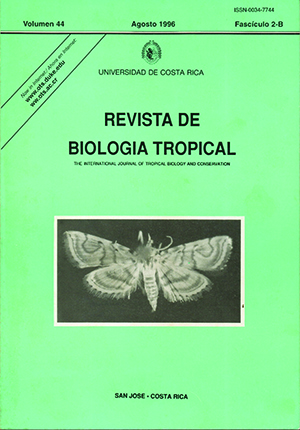Abstract
A hydrophone survey of the northem Gulf of Nicoya was conducted to identify spawning sites used by the corvina aguada (Cynoscíon squamapinnis). Between July 14, and July 17, 1992, thirty-one stations were surveyed during late aftemoon and evening hours. Large aggregations of drumming corvina were located as early as 1606 hrs, but were generally restricted to stations characterized by aboye average depth and moving water. Drumming activity by C. squamapinnis peaked between 1655 and 1910 hrs on four evenings and fully subsided by about 2\00 hrs. In a stepwise regression model, five variables were selected to predict sound intensity. The overall model was statistically significant (P < 0.0001) and explained a high proportion of the variance (R-square = 0.59). The five variables included in the model, in order of decreasing partial R-squares, were tide2 (0.2103), hour3 (0.1470), temperature2 (0.1051), substrate (0.0720), and salinity2 (0.0562). Local gillnet fishermen are familiar with corvina sound production behavior and sorne can identify the drumming species. Corvina fishing takes place only during periods known locally as "mareas de corvina" (Corvina tides), which are those that occur irnmediately after the highest (or lowest) tides of the month, and which gillnet fishermen claim to be the best for fishing. Thus, heaviest fishing concentrates in a period of eight to ten days a month, and we also suspect that fishing during "corvina tides" is focused on natural drumming aggregations. Under present management, the fishery may be reducing natural spawning success and maximizing effort by coinciding temporally with natural spawning aggregations.##plugins.facebook.comentarios##

This work is licensed under a Creative Commons Attribution 4.0 International License.
Copyright (c) 1996 Revista de Biología Tropical
Downloads
Download data is not yet available.


